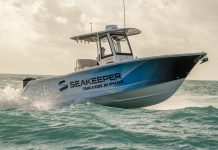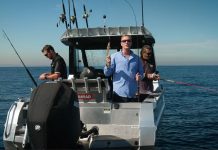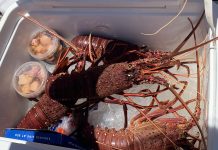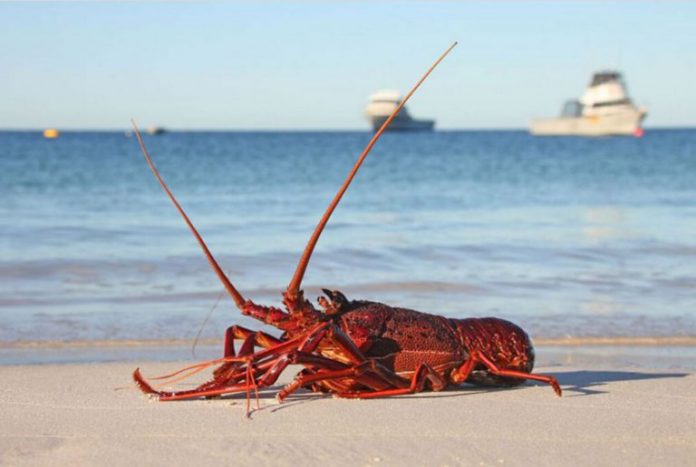by John Bormolini
We’re blessed with a ready abundance of magnificent seafood along the WA coast but I suspect we probably take much of it for granted. Crayfish or more accurately, lobster, are a perfect example and of the four different types of lobster found around our coastline the most well – known is our western rock lobster, found right through the west coast from Cape Leeuwin to Nor West Cape at Exmouth.
I think most would know that western rock lobster has long been the basis a multimillion – dollar professional fishery but for many recreational anglers and boaties catching crays (as we call them) is also a traditional pursuit, especially in the summer holiday months. As a sought – after delicacy the notion of some freshly prepared lobster on the table that has come from your own labours is a great idea but it’s not quite as straight forward or as easy as it appears.
Like all recreational fishing these days, there are strict regulations around the catching of western rock lobster and they can alter every year. The best practice is to not rely on any assumptions or second hand knowledge and refer directly to the latest version of the WA Fisheries guide and regulations on fishing for lobster. The details are very specific and the fines severe for those that don’t pay attention to the exact requirements (see the Rock Lobster Recreational Fishing Guide 2020/2021)
 Currently, it costs fifty dollars for an annual recreational Rock Lobster fishing licence. This allows for a daily bag limit of 8 crays per licence and a maximum of two pots per licence can be set. The minimum legal size is 76 millimetres, measured in the correct spot on the carapace. (head portion of the cray) A maximum of six pots may be pulled from the one boat but the three pot licence holders must be aboard and pulling their pots – pots cannot be pulled for other licence holder or family or friends.) This means the maximum number of crays that can be taken recreationally from one boat in a day is 24, which is very generous especially for those that know what they’re doing.
Currently, it costs fifty dollars for an annual recreational Rock Lobster fishing licence. This allows for a daily bag limit of 8 crays per licence and a maximum of two pots per licence can be set. The minimum legal size is 76 millimetres, measured in the correct spot on the carapace. (head portion of the cray) A maximum of six pots may be pulled from the one boat but the three pot licence holders must be aboard and pulling their pots – pots cannot be pulled for other licence holder or family or friends.) This means the maximum number of crays that can be taken recreationally from one boat in a day is 24, which is very generous especially for those that know what they’re doing.
Recreationally, all species of lobster can be taken year round but essentially, not during night time hours. They cannot be sold by rec. licence holders, in fact legally, they cannot even be exchanged or bartered, for other goods and your licence must be produced on demand to fisheries officers so it must be carried with you.
In a very significant move to assist professional lobster fishermen in WA due to the COVID 19 Pandemic, the state government has amended legislation to enable a professional licence holder to sell up to 100 western rock lobster from their daily catch (from within their quota) directly to the public from the back of their boat. (95 percent of our professional western rock lobster catch is exported, mainly to China) How long this will remain in place remains to be seen but it’s unlikely to put off too many die-hard recreational pot – pullers or divers who enjoy the past time.
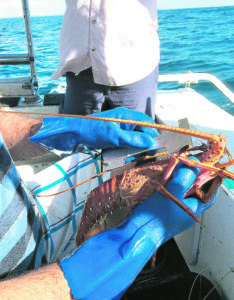 Assuming you’re going to do the amateur thing give it a go this summer there’s a a raft of precise conditions on the two pots each licenced fisher is entitled to use. A recent change for example has been the addition of a required weight for ropes of pots in more than twenty metres of water so that they hang vertically. There’s nothing worse than pots being lost by the ropes being chopped by propellers.
Assuming you’re going to do the amateur thing give it a go this summer there’s a a raft of precise conditions on the two pots each licenced fisher is entitled to use. A recent change for example has been the addition of a required weight for ropes of pots in more than twenty metres of water so that they hang vertically. There’s nothing worse than pots being lost by the ropes being chopped by propellers.
The easy part it getting organised with a licence and gear. The much harder part is actually being successful in terms of good returns. Keep the following pointers in mind –
• Wooden slat pots generally work best but only when heavily weighted to stop them moving about in swells. These days there are smaller “mini” slatted pots which make manual pulling easier but many recreational boats have a fitted electric capstan winch on the side to make hauling the heavily weighted pots an easier task.
• Find broken reefy ground position the pots as close as possible but preferably on sand or flat bottom.
• Bait the pots heavily with oily fish or fish heads. Don’t be too fooled by exotic myths about what else works and be careful about using anything – there are some restrictions on what you may use as bait.
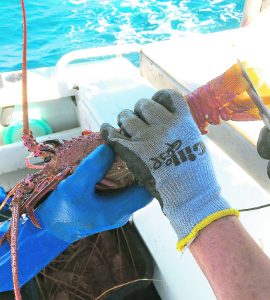 • Pay particular attention to how you treat and check crays that you catch, not simply whether they are size. There are clear rules about how to measure crays, about berried and Setose females, the removal of the maximum size for female lobsters and critically, tail clipping for any crays that are kept.
• Pay particular attention to how you treat and check crays that you catch, not simply whether they are size. There are clear rules about how to measure crays, about berried and Setose females, the removal of the maximum size for female lobsters and critically, tail clipping for any crays that are kept.
Assuming you’ve got the gear and are all set, some good inside knowledge on where to drop your pots in relation the area you plan to try and an understanding of the seasonal movement of crays is important. This will come with experience but be aided by the insight of someone who has done it successfully before. Knowing a professional cray fisherman and being able to pick their brains over a beer can be a great advantage – if they’re amenable.
Finally, none of the above should be even contemplated unless you’ve got commitment. Craypots need to be pulled and checked in the morning, preferably very early and on a daily basis. This allows them to be re set, re baited with fresh bait and moved if necessary, to better ground. It also requires the capacity to get out at times in less than favourable or even difficult conditions which is not always fun. And don’t forget daily wash down, maintenance and fuelling the boat, storing and even cooking the catch and preparing the next day’s bait.
At times its hard work but the results can be very satisfying with the right effort and if it all comes together. Like most things don’t expect the perfect outcome first time but with some perseverance and experience, the catch rates do improve. And enjoy the culinary reward. For me there’s no better way to enjoy our western rock lobster or crays, split and cooked in the shell on the BBQ with the chilled, crisp, white Vermentino. Delicious.






